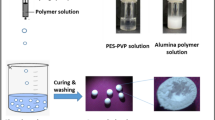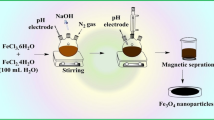Abstract
To investigate the process of RE3+ anti-adsorption on ion-adsorption type rare earth tailings, the thermodynamics, adsorption kinetics and infrared spectroscopy of these materials were investigated. The results indicate that the initial reaction rate of anti-adsorption of rare earth tailings is fast, but it reaches a balance in 6 min. The formula 1 − 2a/3 − (1 − a)2/3 = k2t (k represents rate constant of the reaction, a represents anti-adsorption rate of rare earth ore, t represents anti-adsorption time) of internal diffusion can be used to predict the kinetics of anti-adsorption in IATRE tailings. Because ΔH < 0, ΔG < 0, ΔS > 0 (ΔH, ΔG, ΔS represent change of enthalpy, Gibbs free energy and entropy, respectively), the anti-adsorption of RE3+ on ion-adsorption type RE tailings is a spontaneous physical adsorption process. The effects of ligand exchange and strong chemical bond are not found in this process. Because the anti-adsorption process is exothermic, heating will inhibit the reaction and decrease the anti-adsorption performance. According to the infrared spectrum analysis, there are no significant changes in the mineral surface after anti-adsorption. Based on these findings, the anti-adsorption of rare earth tailings is physical adsorption.









Similar content being viewed by others
References
Li YX, Zhou XM, Liu YZ, Li DP, Li J, Tang Q. Development of high efficiency extraction and separation technologies of rare earths from ion-adsorbed type deposit. J Chin Soc Rare Earths. 2012;30(3):257.
Xiao YF, Huang XW, Feng ZY, Liu XS, Huang L, Long ZQ. Environmental impact assessment and prospect for ion adsorption type rare earths ore leaching by magnesium salt. J Chin Soc Rare Earths. 2015;33(1):1.
Huo MY. Distribution characteristics of the weathering-crust-type rare-earth resources in Nanling, China. J Nat Resour. 1992;7(1):64.
Huang WF, Wen JL, Chen YY. Research status and prospects on flotation reagents and techniques of rare-earth ore. Nonferrous Met Sci Eng. 2012;3(6):75.
Li R. Influence of soil surface potential on ion diffusion/adsorption dynamics. Chongqing: Southwestern University; 2010. 28.
Tang XZ, Li MN, Yang D. The problem of reabsorption of ion-absorbed rare earth mineral in situ leaching mining and the measure to overcome it. J Central South Univ Technol Sci Technol. 1998;29(6):13.
Chi RA, Tian J. Review of weathered crust rare earth ore. J Chin Rare Earth Soc. 2007;25(6):641.
Huang WF, Li XD, Wen JL, Chen YY, Liang J. Recovery of rare earth from low-concentration rare earth ore leaching liquid by HD325 ion-exchange resin. Chin J Rare Met. 2015;39(8):727.
Chen YY. Process and mechanism of ion-exchange method on the recovery of rare earth from discharge liquid of ionic type rare earth mines. Ganzhou: Jiangxi University of Science and Technology; 2014. 67.
Ran Y, Liu Z. Contents and distribution of rare earth elements in main types of soils in China. J Rare Earths. 1992;10(3):248.
Ding WX. Research Trends on rare earth element in soil. Chin J Rare Met. 1995;19(4):290.
Wan YX, Liu CQ. Study on adsorption of rare earth elements by Kaolinite. J Rare Earths. 2004;22(4):507.
Liao CF, Chen JY, Zeng YL, Li AL. Selective reduction leaching of rare earth from waste green phosphor and thermodynamic analysis. Chin Rare Earths. 2015;36(6):7.
Kolonin GR, Shironosova GP. Thermodynamic model of REE leaching from monazite by hydrothermal fluids. Dokl Earth Sci. 2008;423(2):1396.
Shironosova GP, Kolonin GR. Thermodynamic modelling of REE partitioning between monazite, fluorite, and apatite. Dokl Earth Sci. 2013;450(2):628.
Xiao H, Liu G, Xu WN, Xia ZH, Yang YS, Yang Q. Effects of soil particle composition on REE adsorption capacity and erosion tracing precision. J Rare Earths. 2013;31(5):627.
Feng XL, Long ZQ, Cui DL, Wang LS, Huang XW, Zhang GC. Kinetics of rare earth leaching from roasted ore of bastnaesite with sulfuric acid. Trans Nonferrous Met Soc China. 2013;23(3):849.
Chi RA, Zhu GC, Tian J. Leaching kinetics of rare earth from black weathering mud with hydrochloric acid. Chin J Nonferrous Met. 2000;10(4):531.
Thairs S, Ruck S, Jackson SJ, Steelea RJC, Feelyb LC, Washingtonc C, Washingtona N. Effect of dose size, food and surface coating on the gastric residence and distribution of an ion exchange resin. Int J Pharm. 1998;176(1):47.
Harter RD, Baker DE. Applications and misapplications of the Langmuir equation to soil adsorption phenomena1. Soil Sci Soc Am J. 1977;41(6):1077.
Zhang YH. Adsorption. Shanghai: Shanghai Science and Technology Reference Publication; 1989. 125.
Gokmen V, Serpen A. Equilibrium and kinetic studies on the adsorption of dark colored compounds from apple juice using adsorbent resin. J Food Eng. 2002;53(3):221.
Xu HD. Thermodynamics of static ion exchange. Ion Exch Adsorpt. 1987;3(3):54.
Lai H, Luo XP, Zhang YN, Guo ZQ. Adsorption and kinetics of resin on ammonia-nitrogen out of rare earth smelting wastewater. Nonferrous Met Sci Eng. 2012;3(5):74.
Ding SA, Li N, Deng L, Wei J, Deng SQ. Static ion exchange characteristics of tilidine hydrochloride onto Amberlite IRP-69. J Clin Rehabil Tissue Eng Res. 2011;15(8):1381.
He JL. The adsorption thermodynamics study on phenylacetic acid by the new adsorption resins. Ion Exch Adsorpt. 2004;20(2):131.
Chen GH. Applied Physical Chemistry. Beijing: Chemical Industry Press; 2008. 105.
Chu XL, Xu YP, Lu WZ. Research and application progress of chemometrics methods in near infrared spectroscopic analysis. Chin J Anal Chem. 2008;36(5):702.
Chu XL, Lu WZ. Research and application progress of near infrared spectroscopy analytical technology in China in the past five years. Spectrosc Spectr Anal. 2014;34(10):2595.
Huang WF, Zhang HT, Wang JM, Zhong XX. Leaching experiment of semi-weathered ion adsorption type rare earth ore. Nonferrous Met Sci Eng. 2015;6(6):121.
Dubinin MM, Erashko IT, Kadlec O, Ulin VI, Voloshchuk AM, Zolotarev PP. Kinetics of physical adsorption by carbonaceous adsorbents of biporous structure. Carbon. 1975;13(3):193.
Moldoveanu GA, Papangelakis VG. Recovery of rare earth elements adsorbed on clay minerals: desorption mechanism. Hydrometallurgy. 2012;117–118(4):71.
Acknowledgements
This study was financially supported by the National Natural Science Foundation of China (No. 41662004).
Author information
Authors and Affiliations
Corresponding author
Rights and permissions
About this article
Cite this article
Huang, WF., Wu, H., Li, XD. et al. Anti-adsorption mechanism of ion-adsorption type rare earth tailings. Rare Met. 42, 1420–1426 (2023). https://doi.org/10.1007/s12598-018-1018-x
Received:
Revised:
Accepted:
Published:
Issue Date:
DOI: https://doi.org/10.1007/s12598-018-1018-x




